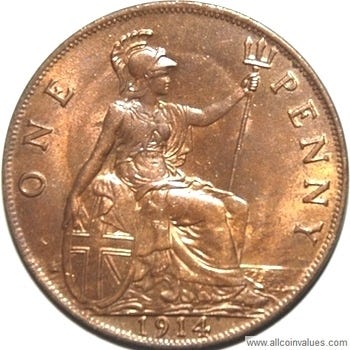When the British one pound note was replaced by a coin in the 1980s my friend wondered why it was so small. ‘It’s so people will expect less,’ said his wife.
The first (1983) pound coin was smaller than the bronze penny pictured above, but weighed about the same; the latest issue is even lighter. In a way it’s a symbol of what inflation has done to our money since the Great War began.
The old penny (1d) was reassuringly substantial. In 1914 it would buy a copy of The Times (the Mail and Express cost a halfpenny). For a shilling (12d) you could get 4 pints of strong pub beer and 20 cigarettes.
There were 20 shillings to the pound, i.e. 240 pennies. Weird system? No, better than decimal, because it’s more useful in dividing up. The modern pound (100 pence) can be split equally in seven ways (2,4,5,10,20,25,50); still, who needs to fiddle about with small change like that? But in 1914 the pound was far more valuable: a baker earned 28-38 shillings a week, a train driver 35-50 shillings.
A duodecimal system is more flexible than 10-based, since it caters for multiples of three. You can split the 240 pence pound in eighteen ways, more if you use the halfpenny or ‘farthing’ (quarter penny). It could relate more easily to time, e.g. 6 working days, 12 months. Even now we count 60 seconds in a minute, 60 minutes in an hour, 24 hours in a day; and as for space, the compass has 360 degrees.
However, even if decimalisation had not been imposed on us for political reasons, inflation would have destroyed the old system by now. The Bank of England’s calculator tells us that to buy £10-worth of goods and services in 1914 you would need over £800 today. The value of our coinage has shrivelled so much that the decimal halfpenny was phased out in 1984 and three years ago there was even talk of abolishing the 1p and 2p coins. By contrast, the old farthing (1/4d), then the smallest coin in the realm, would be equivalent to about 8p today. There’s no going back.
The calculator looks at a basket of prices, because not all have risen at the same rate (and of course we can buy things now that didn’t exist then). Multiplied by 80, the 2d pint would be 66p today (yes!); but a ‘3/6’ (42d) bottle of whisky (also stronger in those days) would be much closer (£14:00) to today’s prices. However, 4d for 20 cigarettes would equate to £1:33 now… surely the enormous real-terms increase in the cost of tobacco is not so much to promote health as to shore up our terrible public finances.
Inflation is not in the natural order of things. The BoE’s basket shows that prices fell by more than a quarter between 1800 and 1914. Holding cash used to be worthwhile - there even used to be ‘penny banks’ for small savers:
For long periods of history, ordinary people could save their pennies knowing that they would still be able to buy things at roughly the same price much later. Today they would be forced to speculate on stocks and shares or other risky ventures.
Of all the many ways in which our governments have let us down, one of the worst is that they have removed any incentive to be prudent savers. Almost the first act of the incoming Conservative-led coalition in 2010 was to stop issuing NS&I Index-Linked Savings Certificates.
Watch your money rot, people.





